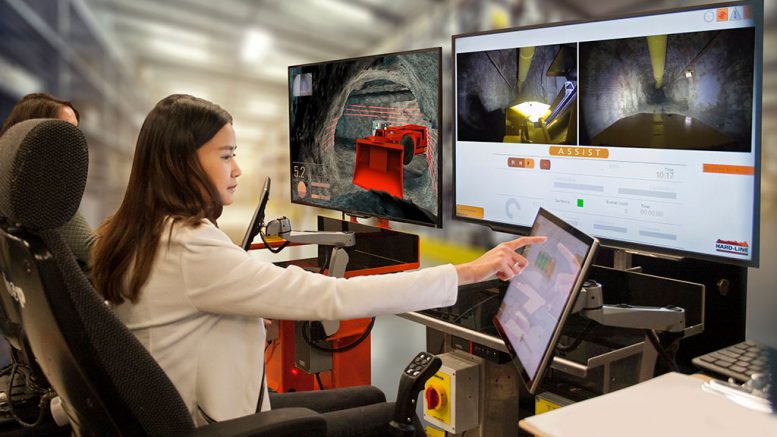From its initial launch in the 1990s, HARD-LINE’s TeleOp system has proven to help mines continuously modernize and streamline their processes. Building off a mine’s existing operational structures, the TeleOp system allows an operator to remotely and simultaneously control multiple machines across multiple sites from an underground- or surface-based remote station.
Backbone networks provide live camera feeds of work-zones and real-time communication with machines for operational monitoring and near-instantaneous control responsiveness. This is accessible from the operator station’s monitor and touchscreen. The operator can use TeleOp to assign machines to automatically perform functions along a pre-set route. This results in reduced machine downtime during shift changes or due to damaging incidents, and greater operator satisfaction by reducing and even eliminating exposure to workplace hazards.
Among TeleOp’s most significant benefits is its ability to act as a springboard for further advancements in efficiency and ease of operation. This brings us to the fast-approaching launch of what will further augment TeleOp’s field-proven system: TeleOp Assist. From the outset, a mining operation already using TeleOp will require minimal additions to use Assist, requiring only access to the relevant machines. Given the backbone network already in place, remote components previously installed on the machine, and no need for a pre-scan of the mine, an operation may implement Assist and be back up and running quickly, with minimal downtime. The installation of lidar sensors on the machine is required to achieve the real-time scans that Assist uses to navigate through any level.
Once installed, Assist can be activated with the touch of a button. Upon activation, Assist instantly equips the base system with intelligent steering assistance and collision detection to keep machines off walls on straightaways and in turns. Using real-time 3D lidar scans, Assist will automatically steer to handle the articulation adjustments required to keep the machine as centered as possible within the drift. All the operator needs to do is maintain throttle input, as well as use the station’s left joystick to indicate direction and to tell Assist which direction to turn next. Assist also will automatically complete a specified turn when it is safe to do so.
Smooth transitions to go from TeleOp driving straight into Assist are also possible, making it easy for operators to call on Assist for help in machine steering. For example, they may load the machine’s bucket using TeleOp control. Then as they leave the muck pile and it’s time for tramming again, they can engage Assist with the touch of a button, and Assist takes over, automatically handling the steering for the operator. This is useful in avoiding equipment damage while navigating through drifts and turns with little clearance on either side of the machine. This is also a perfect fit for drifts that are being blasted and other areas where the surroundings are changing shape, as there is no concern of an old scan becoming irrelevant.
Assist also uses the 3D scans to determine if a space in the drift is wide enough for the machine to travel through, and suspend throttle input if the machine won’t fit. These scans also supply enough data to look ahead and behind the machine to detect obstacles on the driving path. If the machine is jostled from driving over a rut or rock debris, Assist will detect that the machine has been shifted off its driving path and will quickly readjust to center it in the drift as much as possible. Through its type of collision detection, Assist is also able to determine if an obstacle is unsurpassable and stop the machine before it reaches it.
TeleOp Assist boasts the potential to match existing semi-autonomous standards and build upon their foundation with simple installation and enhanced navigational abilities. Combining the base TeleOp system with the augmentation of Assist’s 3D lidar scans and collision detection capabilities promises to be a considerable asset to operators and mines. With the release of Assist this quarter applying to all underground LHDs, and the promise of applications to machines such as trucks in future deliveries, mines may look forward to more ways to continuously improve upon the quality and profitability of their operations. Read More…

